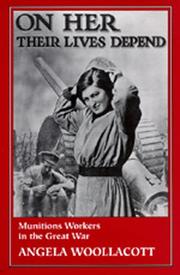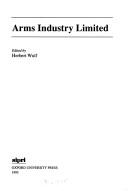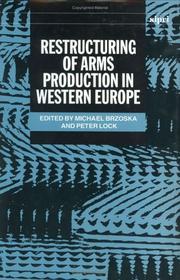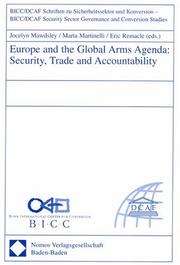| Listing 1 - 10 of 42 | << page >> |
Sort by
|
Book
ISBN: 2738486177 Year: 2000 Publisher: Paris L'Harmattan
Abstract | Keywords | Export | Availability | Bookmark
 Loading...
Loading...Choose an application
- Reference Manager
- EndNote
- RefWorks (Direct export to RefWorks)
Weapons --- Military readiness --- Armes --- Armements --- Weapons industry --- 341.355 --- Arms industry --- Military weapons industry --- Munitions --- Munitions industry --- Defense industries
Book
ISBN: 1921666110 1921666102 9781921666117 9781921666100 Year: 2009 Publisher: Canberra ANU E Press
Abstract | Keywords | Export | Availability | Bookmark
 Loading...
Loading...Choose an application
- Reference Manager
- EndNote
- RefWorks (Direct export to RefWorks)
The continued existence of the Russian defence and arms industry (OPK) was called into question following the disintegration of the Soviet Union in 1991. Industry experts cited the lack of a domestic market, endemic corruption, and excess capacity within the industry as factors underpinning its predicted demise. However, the industry’s export customers in China, India and Iran during those early years became the OPK’s saving grace. Their orders introduced hard currency back into the industry and went a long way to preventing the forecasted OPK collapse. Although pessimistic predictions continued to plague the OPK throughout the 1990s, the valuable export dollars provided the OPK the breathing space it needed to claw back its competitive advantage as an arms producer. That revival has been further underpinned by a new political commitment, various research and development initiatives, and the restoration of defence industry as a tool of Russian foreign policy. The short-term future of the Russian OPK looks promising. The rising domestic defence order is beginning to challenge the export market as the OPK’s most important customer. Meanwhile, exports will be safeguarded by continued foreign demand for niche Russian defence products. Although the long-term future of the OPK is more difficult to predict, Russia’s solid research and development foundation and successful international joint military ventures suggest that the current thriving trend in exports is likely to continue. Russia represents the next generation of affordable and rugged military equipment for the arsenals of the developing world. Coupled with Russia’s growing ability to rearm itself through higher oil prices and a more streamlined defence industry, the future of the OPK looks bright.
Weapons industry --- Arms industry --- Military weapons industry --- Munitions --- Munitions industry --- Defense industries --- Russia --- Russia --- Social conditions. --- Economic conditions.
Book
ISBN: 1911116258 9781911116257 9781788210935 178821093X 9781911116233 9781911116240 191111624X 1911116231 Year: 2023 Publisher: Newcastle upon Tyne Agenda Publishing
Abstract | Keywords | Export | Availability | Bookmark
 Loading...
Loading...Choose an application
- Reference Manager
- EndNote
- RefWorks (Direct export to RefWorks)
An introduction to the economics of the arms industry by one of the world's top defence economists.
Weapons industry. --- Arms industry --- Military weapons industry --- Munitions --- Munitions industry --- Defense industries --- Weapons industry --- Economic aspects --- Military policy --- Economic aspects.
Book
ISBN: 2757422766 2859399917 Year: 2019 Publisher: Villeneuve d'Ascq : Presses universitaires du Septentrion,
Abstract | Keywords | Export | Availability | Bookmark
 Loading...
Loading...Choose an application
- Reference Manager
- EndNote
- RefWorks (Direct export to RefWorks)
De la boutique artisanale à l’atelier flexible, de la proto-industrie aux restructurations, les quatre siècles d’histoire des arsenaux de terre sont ceux des ingénieurs de l’Armement aux sources de la continuité de l’État et des « ouvriers de l’État » dont les privilèges, comme ceux de l’entrepreneur, redessinent l’Ancien Régime, et les statuts successifs les Empires et les Républiques, bref, les consensus nationaux. Les archives nationales et syndicales retracent l’élaboration de la rationalisation du travail ou du concept de « nationalisation » des programmes de gauche. Le syndicalisme naissant, le basculement vers le pacifisme des militants de 1918, l’engagement résistant de ceux de 1940, les révocations des années 1950, le pluralisme syndical de la fin du xxe siècle sont éclairés sous un nouveau jour. Étrange destin que celui d’hommes de paix travaillant pour la guerre ! Illustrissimes, l’on ignorait un peu de ce qu’ils furent : Danton, Thomas, Tillon, Gonin… Inconnus, ils sont parfois essentiels : Gervaise et Voilin, précurseurs de la CGT et de la gauche, les ingénieurs visionnaires Danzel ou Enjalbert… une multitude a contribué à façonner notre monde, militants des villes de manufacture et d’arsenal ou simples héritiers de dynasties ouvrières… Douze larges extraits de documents originaux dont 10 inédits, 32 illustrations, 24 graphiques et tableaux introduisent le lecteur dans cet univers qui n’est autre que le sien… et où la volonté politique l’emporte sur la fatalité, au rebours des idéologies dominantes.
Weapons industry --- Firearms industry and trade --- History. --- Employees --- Arms industry --- Military weapons industry --- Munitions --- Munitions industry --- Defense industries --- histoire --- État --- Grand Siècle --- armuriers --- globalisation

ISBN: 0585079471 0520914651 9780520914650 9780585079479 0520083970 0520085027 Year: 1994 Publisher: [Place of publication not identified] University of California Press
Abstract | Keywords | Export | Availability | Bookmark
 Loading...
Loading...Choose an application
- Reference Manager
- EndNote
- RefWorks (Direct export to RefWorks)
In this evocative book, Angela Woollacott analyzes oral histories, workers' writings, newspapers, official reports, and factory song lyrics to present an intimate view of women munitions workers in Britain during World War I.Munitions work offered working-class women—for the first time—independence, a reliable income, even an improved standard of living. But male employers and trade unionists brought them face-to-face with their subordination as women within their own class, while experiences with middle-class women co-workers and police reminded them of their status as working class.Woollacott sees the woman munitions worker as a powerful symbol of modernity who challenged the gender order through her patriotic work and challenged class differences through her increased spending power, mobility, and changing social behavior.
World War, 1914-1918 --- Weapons industry --- History & Archaeology --- History - General --- Arms industry --- Military weapons industry --- Munitions --- Munitions industry --- Defense industries --- Women --- Employees

ISBN: 0198291647 Year: 1993 Publisher: Oxford Oxford University Press
Abstract | Keywords | Export | Availability | Bookmark
 Loading...
Loading...Choose an application
- Reference Manager
- EndNote
- RefWorks (Direct export to RefWorks)
Industrial economics --- Labour market --- Polemology --- Foreign trade. International trade --- wapenhandel --- Defense industries --- Defensie-industrie --- Industrie de la défense --- 875 Defensiegerelateerde industrie --- 874 Wapenhandel --- Weapons industry --- Arms industry --- Military weapons industry --- Munitions --- Munitions industry --- Case studies

ISBN: 0198291477 Year: 1992 Publisher: Oxford Oxford University Press
Abstract | Keywords | Export | Availability | Bookmark
 Loading...
Loading...Choose an application
- Reference Manager
- EndNote
- RefWorks (Direct export to RefWorks)
Weapons industry --- -#SBIB:327.5H00 --- Arms industry --- Military weapons industry --- Munitions --- Munitions industry --- Defense industries --- Strategie en vredesonderzoek: algemeen --- Defense industriesStrategie en vredesonderzoek: algemeen --- #SBIB:327.5H00 --- Military weapons --- Europe

ISBN: 3832908889 Year: 2004 Volume: 9. Publisher: Baden-Baden Nomos
Abstract | Keywords | Export | Availability | Bookmark
 Loading...
Loading...Choose an application
- Reference Manager
- EndNote
- RefWorks (Direct export to RefWorks)
Weapons industry --- Defense industries --- Armes --- Industrie militaire --- International cooperation. --- Industrie --- Coopération internationale --- Europe --- Military policy. --- Politique militaire --- 870 Defensie en wapens --- 822.5 Europese Unie --- Arms industry --- Military weapons industry --- Munitions --- Munitions industry --- Coopération internationale --- International cooperation
Periodical
Abstract | Keywords | Export | Availability | Bookmark
 Loading...
Loading...Choose an application
- Reference Manager
- EndNote
- RefWorks (Direct export to RefWorks)
Weapons industry --- Firearms industry and trade --- Munitions --- Armes à feu --- Industrie --- Arms industry --- Military weapons industry --- Munitions industry --- Armes à feu --- Firearms industry and trade. --- Weapons industry. --- Defense industries --- Ammunition --- Armes --- Explosives --- Gunnery --- Projectiles --- Ammunition.
Book
ISBN: 0585164312 9780585164311 0809317753 9780809317752 Year: 1992 Publisher: Carbondale, Ill. Southern Illinois University Press
Abstract | Keywords | Export | Availability | Bookmark
 Loading...
Loading...Choose an application
- Reference Manager
- EndNote
- RefWorks (Direct export to RefWorks)
Chemical arms control. --- Chemical weapons --- Weapons industry --- Chemical arms control --- International Law --- Law, Politics & Government --- Treaties, International --- Arms industry --- Military weapons industry --- Munitions --- Munitions industry --- Defense industries --- Weapons of mass destruction --- Chemical weapons control --- Arms control --- Political aspects
| Listing 1 - 10 of 42 | << page >> |
Sort by
|

 Search
Search Feedback
Feedback About UniCat
About UniCat  Help
Help News
News